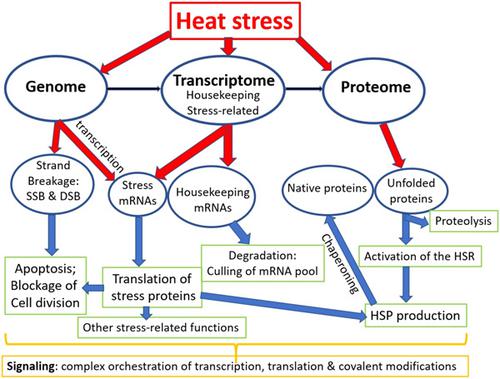当前位置:
X-MOL 学术
›
J. Exp. Zool. Part A
›
论文详情
Our official English website, www.x-mol.net, welcomes your
feedback! (Note: you will need to create a separate account there.)
The cellular stress response and temperature: Function, regulation, and evolution.
Journal of Experimental Zoology Part A ( IF 1.9 ) Pub Date : 2020-01-16 , DOI: 10.1002/jez.2344
George N Somero 1
Journal of Experimental Zoology Part A ( IF 1.9 ) Pub Date : 2020-01-16 , DOI: 10.1002/jez.2344
George N Somero 1
Affiliation

|
The cellular stress response (CSR) is critical for enabling organisms to cope with thermal damage to proteins, nucleic acids, and membranes. It is a graded response whose properties vary with the degree of cellular damage. Molecular damage has positive, as well as negative, function‐perturbing effects. Positive effects include crucial regulatory interactions that orchestrate involvement of the different components of the CSR. Thermally unfolded proteins signal for rapid initiation of transcription of genes encoding heat shock proteins (HSPs), central elements of the heat shock response (HSR). Thermal disruption of messenger RNA (mRNA) secondary structures in untranslated regions leads to the culling of the mRNA pool: thermally labile mRNAs for housekeeping proteins are degraded by exonucleases; heat‐resistant mRNAs for stress proteins like HSPs then can monopolize the translational apparatus. Thus, proteins and RNA function as “cellular thermometers,” and evolved differences in their thermal stabilities enable rapid initiation of the CSR whenever cell temperature rises significantly above the normal thermal range of a species. Covalent DNA damage, which may result from increased production of reactive oxygen species, is temperature‐dependent; its extent may determine cellular survival. High levels of stress that exceed capacities for molecular repair can lead to proteolysis, inhibition of cell division, and programmed cell death (apoptosis). Onset of these processes may occur later in the stress period, after initiation of the HSR, to allow HSPs opportunity to restore protein homeostasis. Delay of these energy costly processes may also result from shortfalls in availability of adenosine triphosphate and reducing power during times of peak stress.
中文翻译:

细胞应激反应和温度:功能,调节和进化。
细胞应激反应(CSR)对于使生物应对蛋白质,核酸和膜的热损伤至关重要。这是一种分级反应,其性质随细胞损伤的程度而变化。分子损伤既有积极的影响,也有消极的影响。积极的影响包括协调企业社会责任不同组成部分的关键监管相互作用。热展开的蛋白质发出信号,指示快速启动编码热激蛋白(HSP)的核心元件即热激蛋白(HSP)的基因的转录。未翻译区域中信使RNA(mRNA)二级结构的热破坏会导致mRNA池的剔除:用于内务处理蛋白的热不稳定mRNA被核酸外切酶降解。压力蛋白(例如HSP)的耐热mRNA可以垄断翻译设备。因此,蛋白质和RNA起到“细胞温度计”的作用,并且当细胞温度显着高于正常物种的正常温度范围时,其热稳定性的不断变化的差异使CSR能够快速启动。共价DNA损伤可能是由于活性氧的产生增加所致,与温度有关;其程度可能决定细胞存活。超过分子修复能力的高水平应激会导致蛋白水解,抑制细胞分裂和程序性细胞死亡(细胞凋亡)。这些过程的发作可能在HSR启动后的应激期后期发生,以使HSP有机会恢复蛋白质稳态。
更新日期:2020-01-16
中文翻译:

细胞应激反应和温度:功能,调节和进化。
细胞应激反应(CSR)对于使生物应对蛋白质,核酸和膜的热损伤至关重要。这是一种分级反应,其性质随细胞损伤的程度而变化。分子损伤既有积极的影响,也有消极的影响。积极的影响包括协调企业社会责任不同组成部分的关键监管相互作用。热展开的蛋白质发出信号,指示快速启动编码热激蛋白(HSP)的核心元件即热激蛋白(HSP)的基因的转录。未翻译区域中信使RNA(mRNA)二级结构的热破坏会导致mRNA池的剔除:用于内务处理蛋白的热不稳定mRNA被核酸外切酶降解。压力蛋白(例如HSP)的耐热mRNA可以垄断翻译设备。因此,蛋白质和RNA起到“细胞温度计”的作用,并且当细胞温度显着高于正常物种的正常温度范围时,其热稳定性的不断变化的差异使CSR能够快速启动。共价DNA损伤可能是由于活性氧的产生增加所致,与温度有关;其程度可能决定细胞存活。超过分子修复能力的高水平应激会导致蛋白水解,抑制细胞分裂和程序性细胞死亡(细胞凋亡)。这些过程的发作可能在HSR启动后的应激期后期发生,以使HSP有机会恢复蛋白质稳态。




































 京公网安备 11010802027423号
京公网安备 11010802027423号